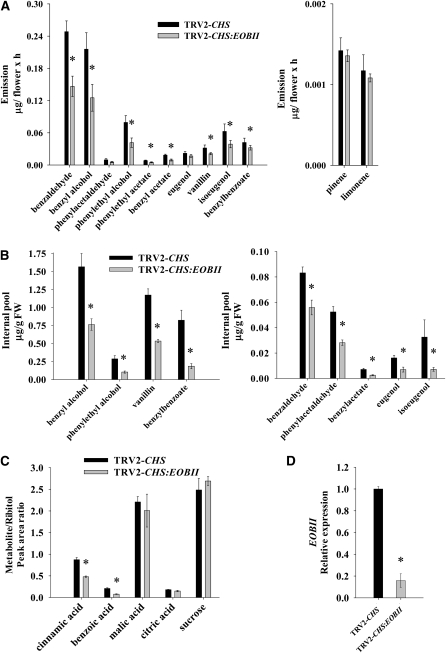Figure 3.
Suppression of EOBII Expression Reduces Levels of Volatile Phenylpropanoids in Petunia Flowers.
(A) Dynamic headspace analyses, followed by GC-MS, were performed (from 17 h00 to 09 h00) on TRV2-CHS:EOBII–infected flowers. Flowers of plants infected with TRV2-CHS were used as controls. Graphs represent the average of seven to nine independent experiments with standard errors indicated by vertical lines. Bars with asterisks are significantly different (P ≤ 0.05) from their corresponding controls. The significance of differences between treatment and control samples (asterisks) was calculated using Student's t test.
(B) Internal pools of volatile compounds accumulated in corollas 1 dpa (collected at 07 h00) of EOBII-silenced plants compared with corollas of TRV2-CHS–infected plants. Columns represent the mean values of three to five independent experiments. Standard errors are indicated by vertical lines. Bars with asterisks are significantly different (P ≤ 0.05).
(C) Levels of metabolites collected from EOBII-silenced and TRV2-CHS–infected corolla limbs at anthesis (collected at 07 h00) as determined by GC-MS analysis of samples derivatized with N-methyl-N-(trimethylsilyl)trifluoroacetamide using ribitol as an internal standard. Columns represent the mean values of three independent experiments. Standard errors are indicated by vertical lines. Bars with asterisks are significantly different (P ≤ 0.05) from their corresponding controls.
(D) Quantitative real-time PCR analysis was used to determine EOBII transcript levels in petunia flowers infected with TRV2-CHS and TRV2-CHS:EOBII. Presented data were normalized to that from TRV2-CHS–infected corollas, with standard errors indicated by vertical lines. Significance of differences (P ≤ 0.05; n = 3) between treatments (asterisks) was calculated (Student's t test) based on the raw transcript levels' data normalized to Actin.

